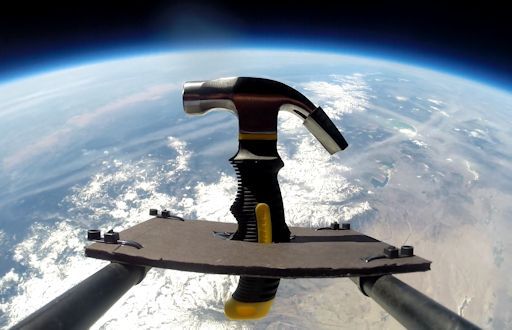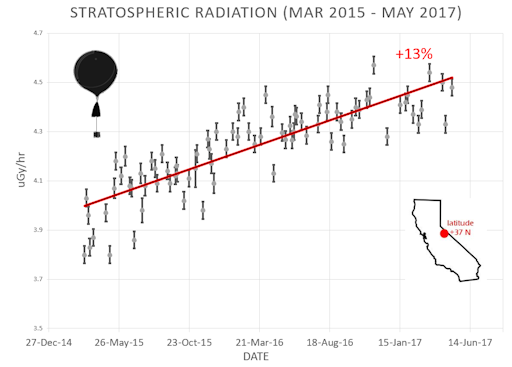Lights Over lapland is excited to announce that Autumn Aurora Adventures are available for immediate booking! Reserve your adventure of a lifetime in Abisko National Park, Sweden today! | | |
SLIGHT CHANCE OF FLARES: Today, NOAA forecasters say there is a 10% chance of M-class solar flares from sunspot AR2661, which has an unstable 'delta-class' magnetic field. If AR2661 does explode, the resulting flare would be geoeffective because the sunspot is directly facing our planet. Free Solar Flare Alerts
DAYTIME METEOR SHOWER: This week, Earth is passing through a stream of debris from an unknown source, and the encounter is causing a meteor shower in broad daylight. The shooting stars are mostly invisible to the human eye. Astronomers know the shower is underway because the meteors reflect radio waves. According to data from Canada's Meteor Orbit Radar (CMOR), there is a hot spot of activity right now in the constellation Aries not far from the sun:

This happens every year in early June, and the resulting Arietid meteor shower typically peaks on June 7th. If you could turn off the sun, you would see more than 60 meteors per hour, making it one of the most active showers of the year. No one is sure where Arietid meteoroids come from, although some astronomers suspect they are debris from sungrazing asteroid 1566 Icarus. Another candidate is comet 96P/Machholz.
In fact, there is way to see a few of these meteors. Try looking just before sunrise. The shower's radiant (labeled ARI in the radar map above) rises in the east about 45 minutes before the sun. At that time of day, Arietids tend to be "Earthgrazers," i.e., meteors that skim horizontally through the upper atmosphere from radiants near the horizon. Spectacular Earthgrazers are usually slow and bright, streaking far across the sky--a real eye-opener. Sky maps: northern hemisphere, southern hemisphere.
Realtime Space Weather Photo Gallery
RED SPRITES OVER EUROPE: High above thunderstorms in Europe, red sprites are dancing across the cloudtops. Martin Popek of Nýdek, Czech republic, photographed these specimens on June 1st:

"The transient forms were shooting up from a storm in Slovenia," says Popek.
Reaching up to the edge of space, sprites are a true space weather phenomenon. Some researchers believe they are linked to cosmic rays: subatomic particles from deep space striking the top of Earth's atmosphere produce secondary electrons that, in turn, provide the spark that triggers sprites. If this is true, then sprites could multiply in the years ahead as cosmic rays intensify due to the decline of the solar cycle.
Although sprites have been seen for at least a century, most scientists did not believe they existed until after 1989 when sprites were photographed by cameras onboard the space shuttle. Now "sprite chasers" routinely photograph sprites from their own homes. "I used up a Watec 910HX security camera with UFOCapture software to catch my sprites," says Popek. Give it a try!
diagram: How to Look for Sprites
Realtime Sprite Photo Gallery
THE SPACE HAMMER FOR FATHER'S DAY: Just in time for Father's Day: The Space Hammer. On June 2nd, the students of Earth to Sky Calculus flew a payload of hammers to the edge of space, 35.0 km (115,000 feet) above Earth's surface on board a high altitude helium balloon. You can have one for $99.95:

These compact 8 oz. hammers are light enough to fly on a balloon yet dense enough to deliver a powerful blow. The magnetic head holds a nail for one-handed starting, and the stubby 6 in. length is perfect for tight work areas.
Each space hammer comes with a unique gift card showing the tool floating at the top of Earth's atmosphere. The interior of the card tells the story of the flight and confirms that this gift has been to the edge of space and back again.
More edge of space Father's Day gifts may be found in the Earth to Sky Store.
Far Out Gifts: Earth to Sky Store
All proceeds support hands-on STEM education
Realtime Aurora Photo Gallery
Realtime Noctilucent Cloud Photo Gallery
Realtime Comet Photo Gallery
Every night, a network of
NASA all-sky cameras scans the skies above the United States for meteoritic fireballs. Automated software maintained by NASA's Meteoroid Environment Office calculates their orbits, velocity, penetration depth in Earth's atmosphere and many other characteristics. Daily results are presented here on Spaceweather.com.
On Jun. 6, 2017, the network reported 5 fireballs.
(5 sporadics)

In this diagram of the inner solar system, all of the fireball orbits intersect at a single point--Earth. The orbits are color-coded by velocity, from slow (red) to fast (blue). [Larger image] [movies]
Potentially Hazardous Asteroids (
PHAs) are space rocks larger than approximately 100m that can come closer to Earth than 0.05 AU. None of the known PHAs is on a collision course with our planet, although astronomers are finding
new ones all the time.
On June 6, 2017 there were 1803 potentially hazardous asteroids.
 |
Recent & Upcoming Earth-asteroid encounters: | Asteroid | Date(UT) | Miss Distance | Velocity (km/s) | Diameter (m) |
| 418094 | 2017-Jun-01 | 8 LD | 23.2 | 490 |
| 2017 KX4 | 2017-Jun-01 | 15.2 LD | 9.4 | 47 |
| 2017 KJ3 | 2017-Jun-03 | 11.1 LD | 11.3 | 48 |
| 2017 KJ5 | 2017-Jun-04 | 11.6 LD | 3.7 | 17 |
| 2017 LG | 2017-Jun-04 | 12.2 LD | 6.3 | 39 |
| 2017 KK27 | 2017-Jun-04 | 15.7 LD | 6.5 | 29 |
| 2017 LD | 2017-Jun-05 | 3 LD | 4.8 | 10 |
| 2017 KR27 | 2017-Jun-06 | 7 LD | 12.6 | 71 |
| 2017 KQ27 | 2017-Jun-06 | 1 LD | 10.7 | 24 |
| 2017 LE | 2017-Jun-07 | 5.2 LD | 9 | 19 |
| 2017 HV4 | 2017-Jun-10 | 19.5 LD | 3.9 | 50 |
| 2017 KF3 | 2017-Jun-11 | 12.9 LD | 11.2 | 40 |
| 2010 VB1 | 2017-Jun-16 | 10.3 LD | 8.3 | 81 |
| 471984 | 2017-Jun-18 | 19.1 LD | 7.7 | 102 |
| 441987 | 2017-Jun-24 | 7.9 LD | 12.7 | 178 |
| 2017 BS5 | 2017-Jul-23 | 3.2 LD | 5.8 | 54 |
Notes: LD means "Lunar Distance." 1 LD = 384,401 km, the distance between Earth and the Moon. 1 LD also equals 0.00256 AU. MAG is the visual magnitude of the asteroid on the date of closest approach. | | Cosmic Rays in the Atmosphere |
Readers, thank you for your patience while we continue to develop this new section of Spaceweather.com. We've been working to streamline our data reduction, allowing us to post results from balloon flights much more rapidly, and we have developed a new data product, shown here:

This plot displays radiation measurements not only in the stratosphere, but also at aviation altitudes. Dose rates are expessed as multiples of sea level. For instance, we see that boarding a plane that flies at 25,000 feet exposes passengers to dose rates ~10x higher than sea level. At 40,000 feet, the multiplier is closer to 50x. These measurements are made by our usual cosmic ray payload as it passes through aviation altitudes en route to the stratosphere over California.
What is this all about? Approximately once a week, Spaceweather.com and the students of Earth to Sky Calculus fly space weather balloons to the stratosphere over California. These balloons are equipped with radiation sensors that detect cosmic rays, a surprisingly "down to Earth" form of space weather. Cosmic rays can seed clouds, trigger lightning, and penetrate commercial airplanes. Furthermore, there are studies ( #1, #2, #3, #4) linking cosmic rays with cardiac arrhythmias and sudden cardiac death in the general population. Our latest measurements show that cosmic rays are intensifying, with an increase of more than 13% since 2015:

Why are cosmic rays intensifying? The main reason is the sun. Solar storm clouds such as coronal mass ejections (CMEs) sweep aside cosmic rays when they pass by Earth. During Solar Maximum, CMEs are abundant and cosmic rays are held at bay. Now, however, the solar cycle is swinging toward Solar Minimum, allowing cosmic rays to return. Another reason could be the weakening of Earth's magnetic field, which helps protect us from deep-space radiation.
The radiation sensors onboard our helium balloons detect X-rays and gamma-rays in the energy range 10 keV to 20 MeV. These energies span the range of medical X-ray machines and airport security scanners.
The data points in the graph above correspond to the peak of the Reneger-Pfotzer maximum, which lies about 67,000 feet above central California. When cosmic rays crash into Earth's atmosphere, they produce a spray of secondary particles that is most intense at the entrance to the stratosphere. Physicists Eric Reneger and Georg Pfotzer discovered the maximum using balloons in the 1930s and it is what we are measuring today.
| | The official U.S. government space weather bureau |
| | The first place to look for information about sundogs, pillars, rainbows and related phenomena. |
| | Researchers call it a "Hubble for the sun." SDO is the most advanced solar observatory ever. |
| | 3D views of the sun from NASA's Solar and Terrestrial Relations Observatory |
| | Realtime and archival images of the Sun from SOHO. |
| | from the NOAA Space Environment Center |
| | a proud supporter of science education and Spaceweather.com |
| | fun to read, but should be taken with a grain of salt! Forecasts looking ahead more than a few days are often wrong. |
| | from the NOAA Space Environment Center |
| | the underlying science of space weather |
 | Beautyz for top beauty products reviews and their buying guides |
 | Reviews here can help you to pick up best memory foam mattresses. |
| | These links help Spaceweather.com stay online. Thank you to our supporters! |
| | | | | | |

